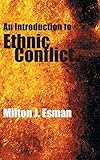An introduction to ethnic conflict / Milton J. Esman.
Material type: TextPublication details: Cambridge ; Malden, MA : Polity Press, 2004.Description: vii, 232 p. ; 24 cmISBN:
TextPublication details: Cambridge ; Malden, MA : Polity Press, 2004.Description: vii, 232 p. ; 24 cmISBN: - 0745631169
- 0745631177 (pbk.)
- 9780745631172
- 305.8
- HM 1121 E76i 2004
| Item type | Current library | Home library | Collection | Shelving location | Call number | Vol info | Copy number | Status | Date due | Barcode |
|---|---|---|---|---|---|---|---|---|---|---|
 Libro
Libro
|
Biblioteca Juan Bosch | Biblioteca Juan Bosch | Ciencias Sociales | Ciencias Sociales (3er. Piso) | HM 1121 E76i 2004 (Browse shelf(Opens below)) | 4 | 1 | Available | 00000107770 |
Includes bibliographical references (p. [213]-226) and index.
Written by one of the world's leading scholars in the field, this book provides and excellent introduction to ethnic conflict in the contemporary world. In ten concise chapters, Milton Esman explores the origins of ethnic pluralism and analyses the causes and manifestations of conflicts, both peaceful and violent, involving ethnic communities across the globe. He discusses the role of outsider-governments, diasporas, interntional agencies, and non-government organizations in provoking and managing ethnic conflicts, and appraises methods wich have proven effective for their peaceful resolution. The book concludes with a look at the future ogf ethnic conflict and argues for the need to regulate such conflicts in an increasingly interdependent world. -- Cover


There are no comments on this title.